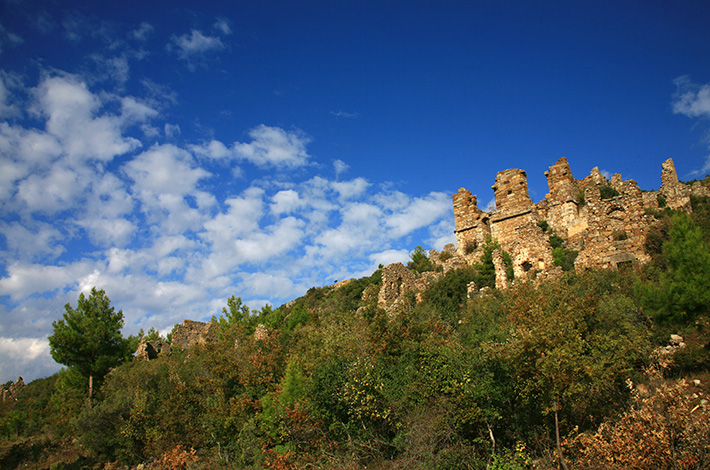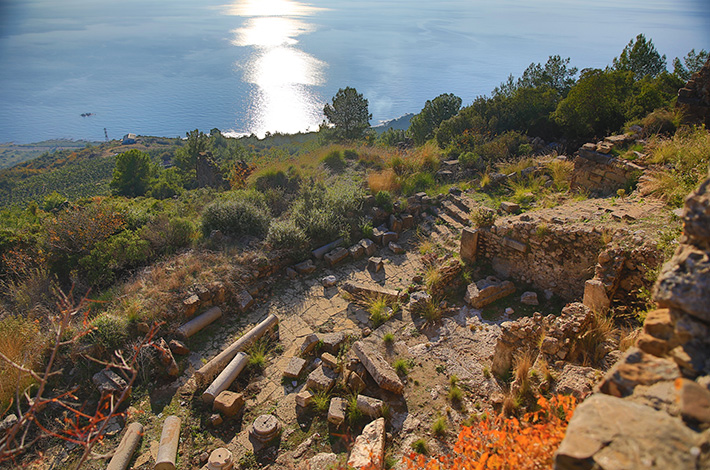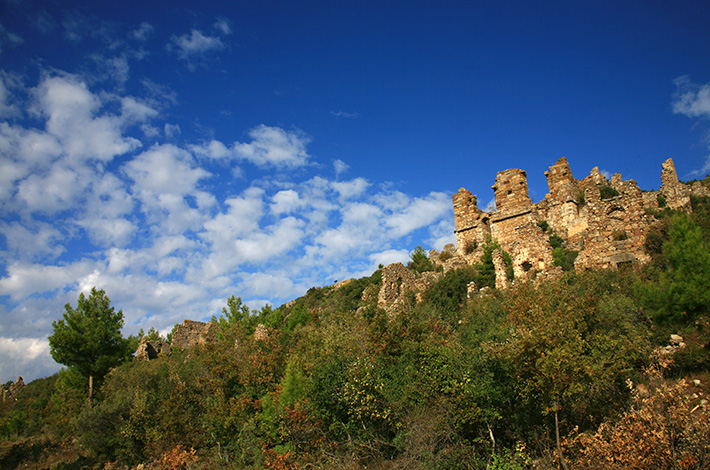Syedra is located approximately 20 km from Alanya and offers a panoramic view of the Mediterranean. Founded in the 7th century BC, it was strategically positioned on a critical point of the road following the Mediterranean coastline to the south of the Taurus Mountains. Syedra was a significant sports hub and experienced its most prosperous years in the 2nd to 4th centuries AD. It was abandoned, along with other settlements, in the 13th century. It is possible to travel through time within ancient buildings that have been uninhabited for centuries. Syedra has both mountainous and coastal features. The Lower City extends from the southwestern slopes to the coastline, where some building remains and mosaics have been discovered. However, the majority of the settlement is located in the Upper City, which is situated on a slope at an altitude of 400 meters. The buildings were gradually placed, and stairs were used to transition between different levels. Access to the Upper City is through a monumental gate, as it was hundreds of years ago. The 250-metre-long colonnaded street beyond the gate was once the social centre of the city, where people gathered most intensively. Research has revealed that part of the street was covered with a roof to protect people from the sun. The Heroon is a monumental tomb situated at the western end of the Colonnaded Street, accessible by stairs. It provides a picturesque view of the Mediterranean. The ruins of the bath, one of the city's most magnificent buildings, reveal that its floor was once entirely covered with mosaics. Other structures, such as the gymnasium where sports competitions were held and olive processing workshops, offer insight into how life was once lived in the city. The Cistern Cave is a plaster-covered water source, one of many in the city that local people still use for irrigation. Close by is the Baptism Cave, which is carved out of rocks and decorated with frescoes. It is named after a pool inside.
Syedra is located about 20 km from Alanya, offering a bird’s-eye view of the Mediterranean. The city’s foundation dates back to the 7th century BC. It was among the most strategic cities of the region due to its location on a critical points of the road following the Mediterranean coastline to the south of the Taurus Mountains. Syedra was a significant sports hub and have the most glorious years in the 2nd to 4th centuries AD. It was abandoned along with other settlements in the 13th century. But it is still possible to take a time travel within ancient buildings where nobody lived for centuries. Syedra had the characteristics of both a mountain and a coastal city. The Lower City extends from the southwestern slopes to the coastline. Some building remains and mosaics were discovered in this section of the city. However, the settlement is mostly in the Upper City. The Upper City was on a slope at an altitude of 400 meters. The buildings here were placed gradually and the transition between different levels were provided by stairs. The Upper City is entered through a monumental gate as it was hundreds of years ago. The 250-metre-long colonnaded street just beyond the gate was once the social centre of the city and the place where people gathered most intensively. Research has revealed that part of the street was covered with a roof, thus protecting the people from the sun. The Heroon, the monumental tomb, located at the western end of the Colonnaded Street and reached by stairs, is also one of the most beautiful places to watch the Mediterranean view. The ruins of the bath, one of the most magnificent buildings of the city, prove that its floor was once completely covered with mosaics. The gymnasium, where sports competitions were held, and olive processing workshops are other structures that give clues about how life was once lived in the city. The "Cistern Cave" is one of the water sources of the cisterns, the interior of which is covered with plaster and of which there are many examples in the city. These cisterns are still used for irrigation purposes by the local people today. Another interesting place is the Baptism Cave, which is close to this cave. The cave, carved out of rocks and decorated with frescoes, is so named because of a pool in it.





